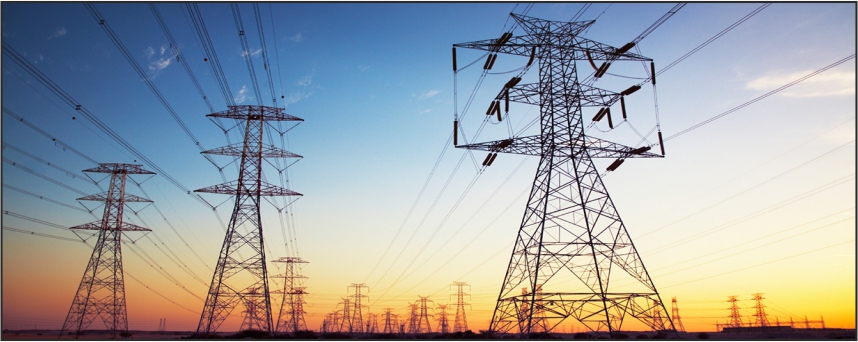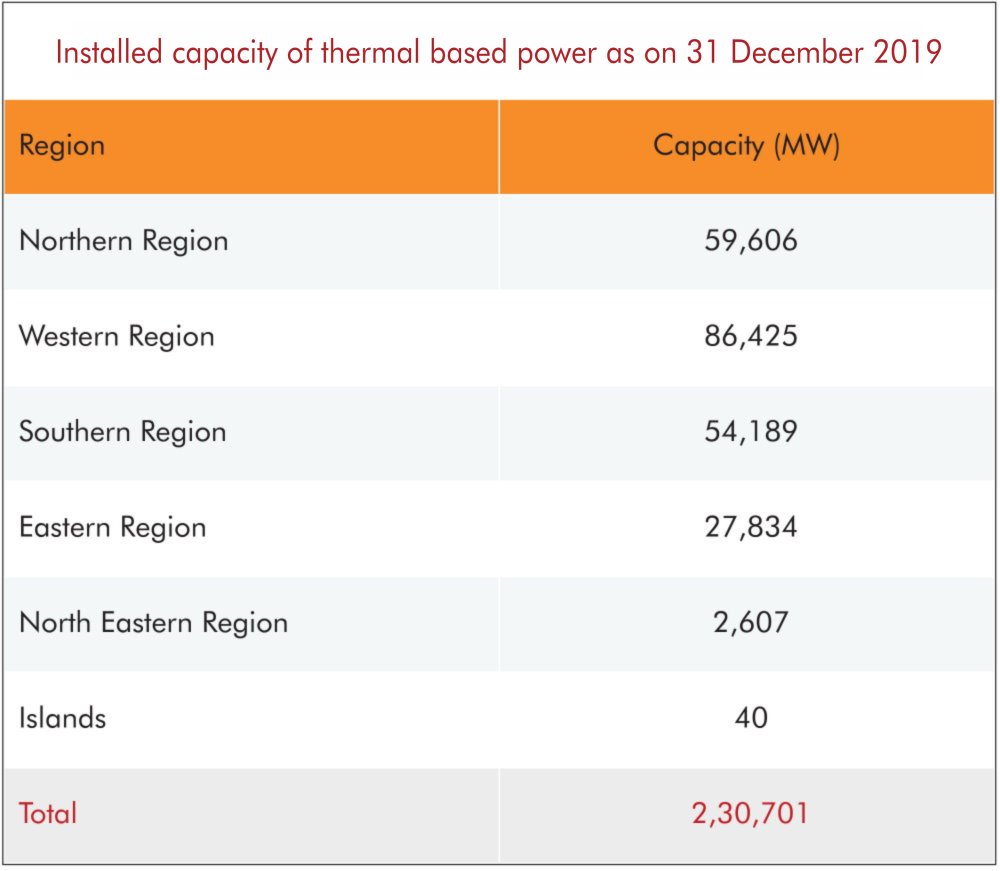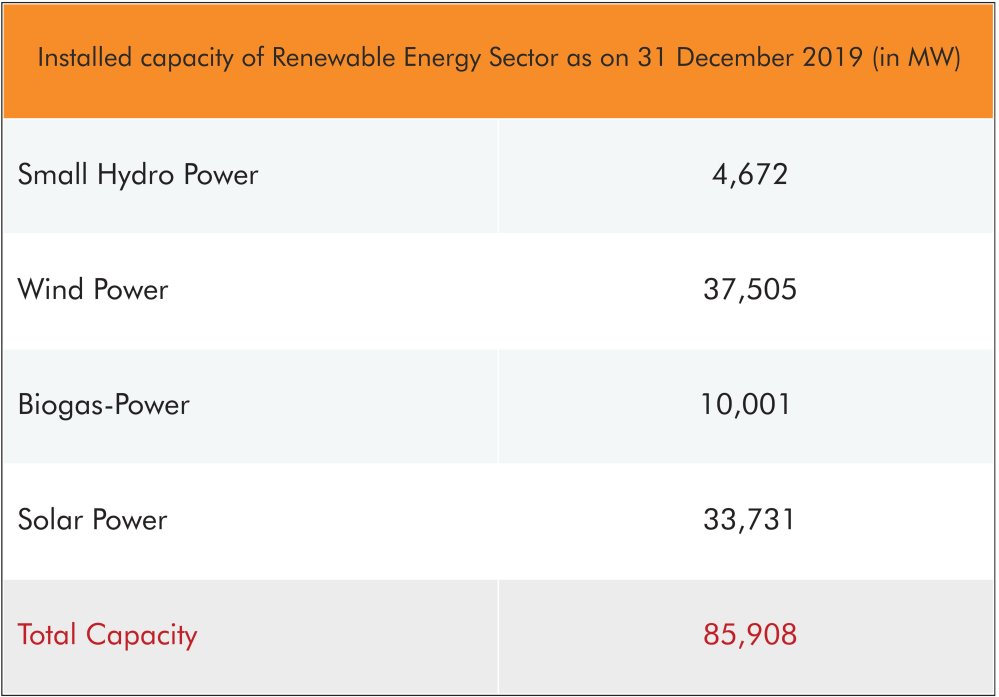India’s total installed power capacity crosses 368 GW as on 2019-end

The country’s total installed power capacity stood at 368.79 GW as on 31 December 2019. Of the total installed capacity almost half was accounted by the Private sector. The Private sector accounted for 47 percent of the total share with 172.177 GW, followed by state governments with 103.815 GW (28 percent share) and the remaining by the Central government with 92.797 GW installed capacity.
Of the total, Thermal-based power sector accounted for 62.56 percent of the total share of the installed capacity across India as on 31 December 2019. The cumulative installed capacity by thermal-based power sector was 230.701 GW. Of this the installed capacity of Coal and Lignite was 205.254 GW, Gas was 24.937 GW and from Diesel was 510 MW.
In terms of area, majority of the installed projects of thermal-based power sector are in Northern and Western Region. In both these regions the capacity has reached 146.031 GW as on December 2019-end. In Northern Region, states such as Uttar Pradesh, Rajasthan, Haryana and Punjab have majority of the installed thermal power capacity. The installed thermal power capacity has reached 19.140 GW in Uttar Pradesh while that in Rajasthan it is 12.45 GW by the end of 2019.
In Western Region, the installed capacity of thermal power utilities reached 86.42 GW. States including Maharashtra, Gujarat and Madhya Pradesh have installed capacity of 30.33 GW, 23.18 GW and 16.14 GW respectively, as on 31 December 2019.

Source: cea.nic.in
As part of the Paris Accord on Climate Change, India made a pledge that by 2030, 40 percent of the country’s installed power generation capacity will be from non-fossil fuel sources and by 2030 it will reduce emission intensity of GDP by 33-35 percent from 2005 level.
Keeping the commitment in mind the country in 2015 targeted that 175 GW of renewable energy capacity will be installed by year 2022. This includes 100 GW from solar, 60 GW from wind, 10 GW from biomass and five GW from small hydro power.
As on December 2019 end, total installed power capacity from the Renewable Energy sector surpassed 85.908 GW. This includes projects of Small Hydro power, Wind power, Bio-power, Solar power. The installed capacity from Solar projects stood at 33.730 GW while that from Wind power projects was 37.505 GW.

Source: cea.nic.in
One of the major highlights in the renewable power sector was the world’s largest solar park, Pavagada Solar Park of 2050 MW, is now operational. The park, located in Tumakuru district of Karnataka, has been developed by the Karnataka Solar Park Development Corporation (KSPDCL), a joint venture between the Solar Energy Corporation of India (SECI) and the Karnataka Renewable Energy (KREDL).
Out of the total 2,050 MW capacity, NTPC implemented 600 MW Solar PV projects, SECI implemented 200 MW, while KREDL implemented 1,250 MW.
The installed capacity of Hydro Power projects was 45.40 GW as of December 2019. The total installed capacity by various state government agencies stood at 26.95 GW, by the Central government at 15.04 GW and by private organisations at 3.40 GW. Similarly, the installed capacity by Nuclear-based Power projects has reached 6,780 MW as on 31 December 2019. A total of 22 nuclear reactors are operating above 80 percent plant load factor in the country.
However, in recent times, the overall power sector is facing huge challenges due to fall in demand, decline in coal imports, unable to ink pacts with distribution utilities for sale of power, financial crisis, among others.
As per the 77th Survey of Projects Investment in India conducted by Projects Today, the overall fresh investment declined sharply by 77.9 percent in Q3/FY20. The fresh investment in this sector came down to Rs 14,478 crore in Q3/FY20. The 20 new renewable power projects and a couple of hydel power projects could not match the amount of projex the sector had attracted in Q2/FY20. The last quarter had seen announcement of 71 projects worth Rs 65,616.3 crore which included 10 large thermal power projects and 58 renewable power projects worth Rs 59,379.53 crore. In Q1/FY20 too fresh investment was seen at Rs 10,861 crore.
In a move to help discoms with dues with help of the private sector, the Ministry of New and Renewable Energy (MNRE) has proposed an idea which involves bundling renewable energy and thermal power.
The government has released a draft paper with an aim achieve a medium of availability, cost and renewable energy. The capacity additions in renewable energy make a case for ‘Reverse Bundling’, wherein high cost thermal power is allowed to be bundled with cheaper renewable energy and provided round-the-clock to the discom. This can also bring down power buying costs for the discom.
The draft also includes that discoms will not have to integrate renewable energy power into the grid since the responsibility of giving firm power will be with the power generator. It has also called on power generators to supply 51 percent power annually from renewable energy power and the remaining from thermal power.
The draft also states that the power generator can combine storage for ensuring that it achieves the required minimum annual availability of 80 percent.